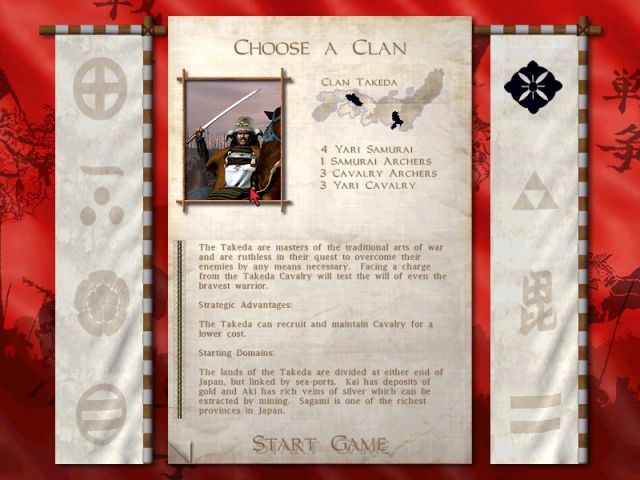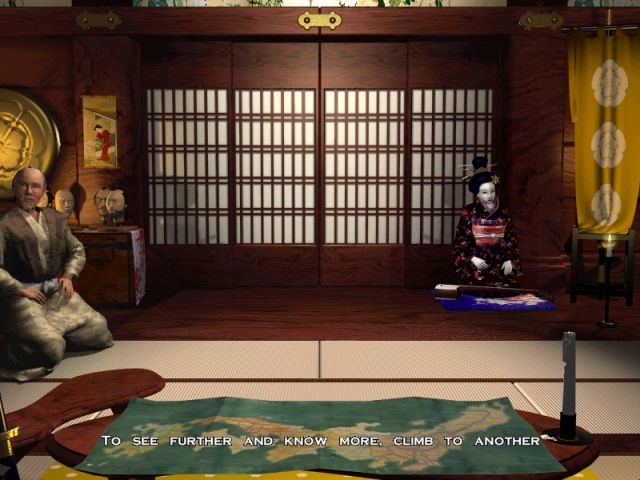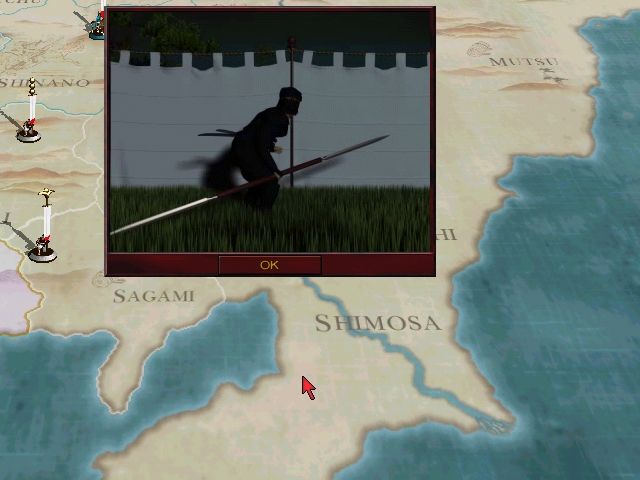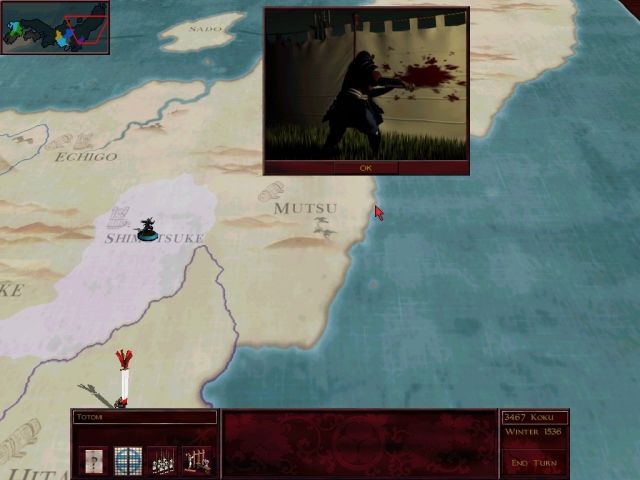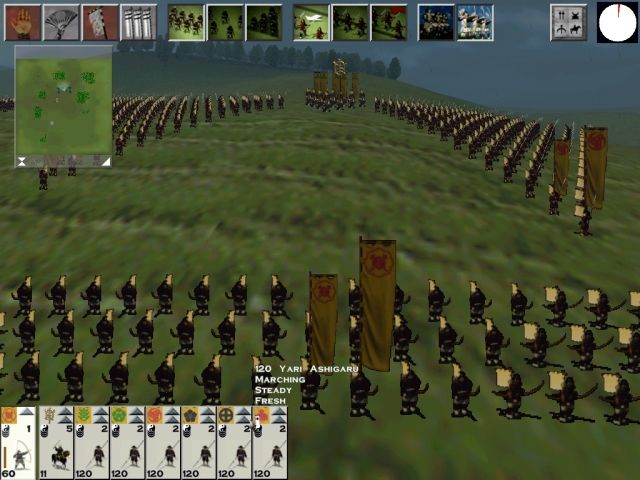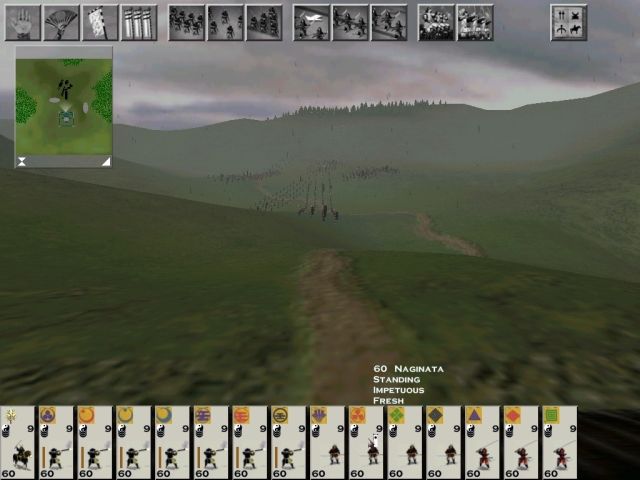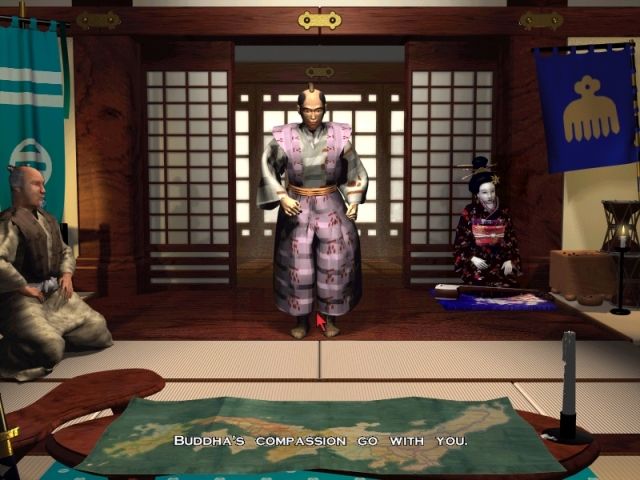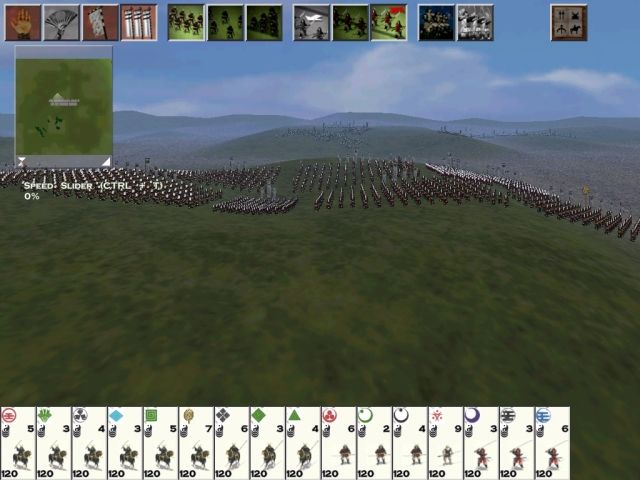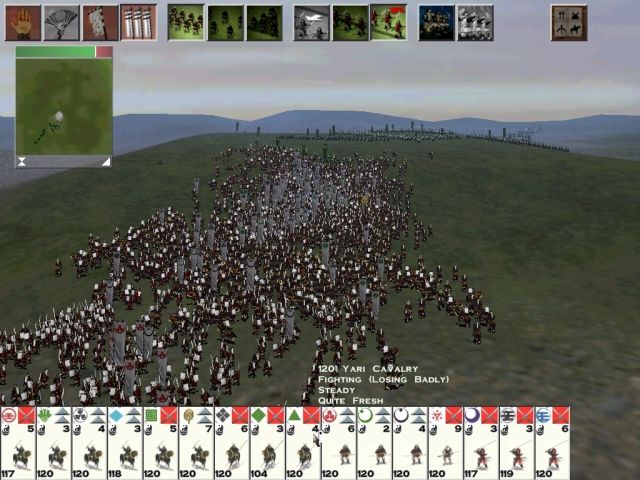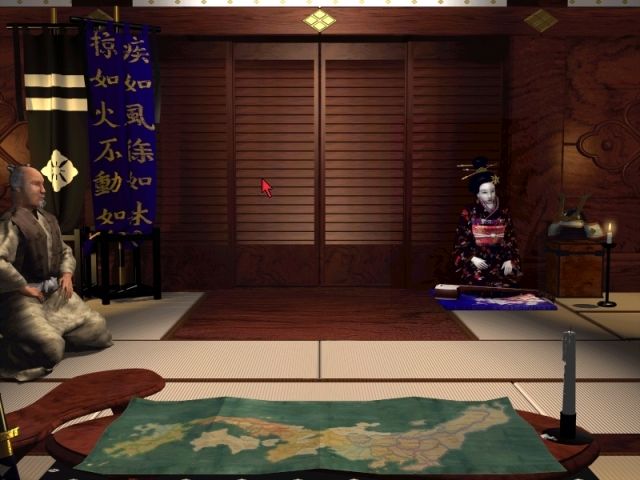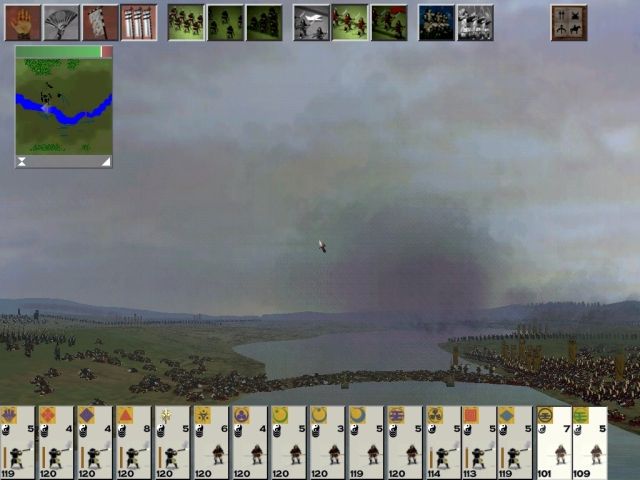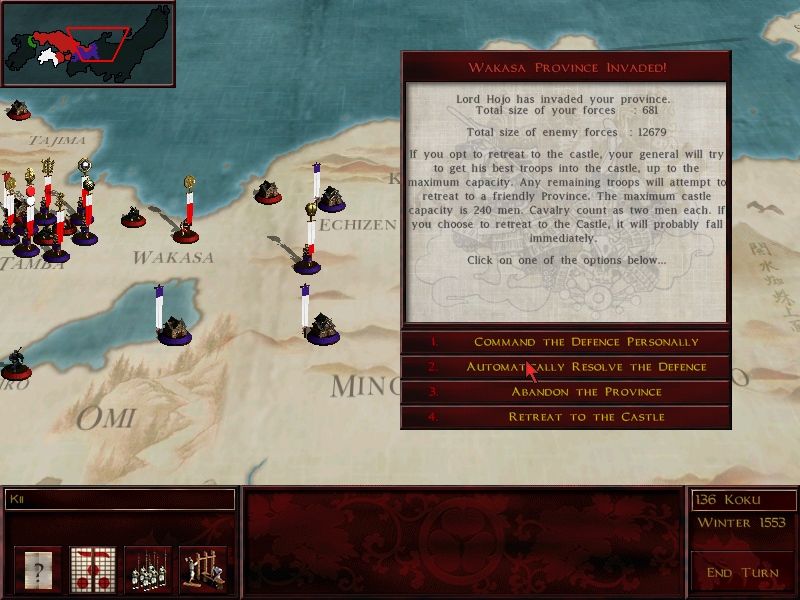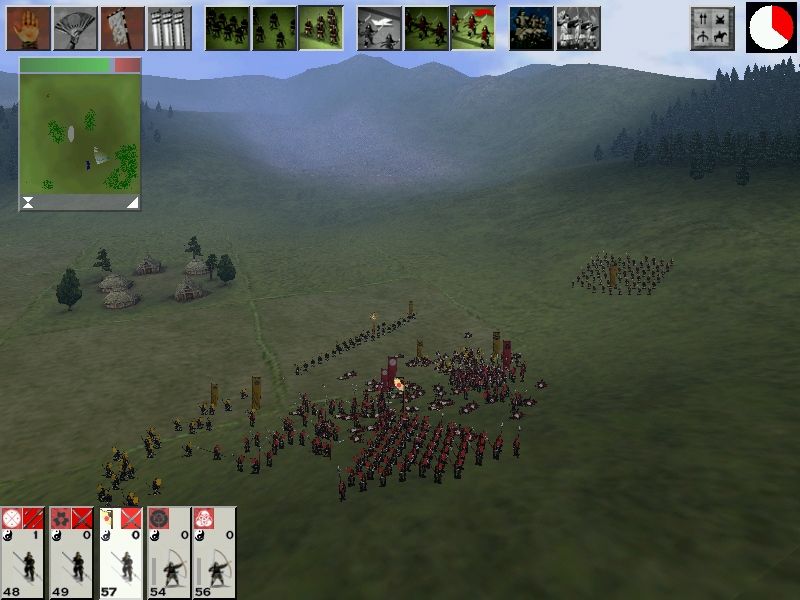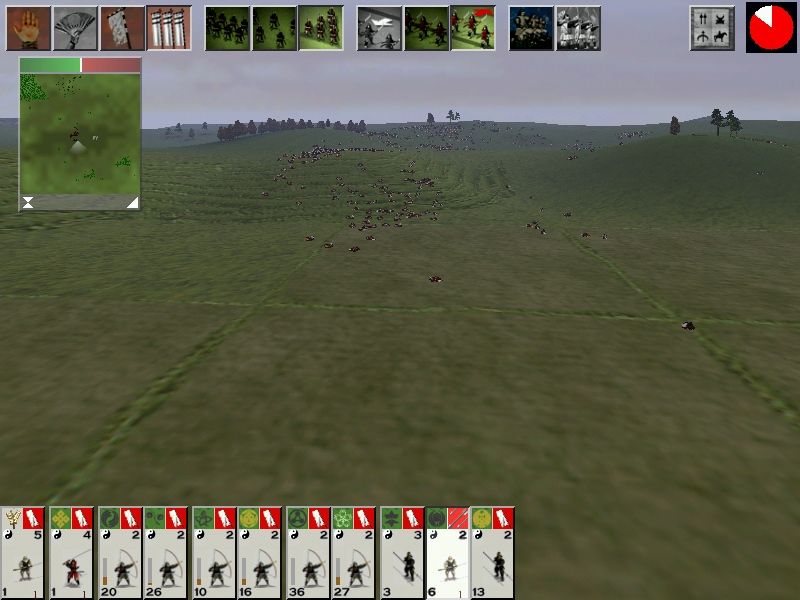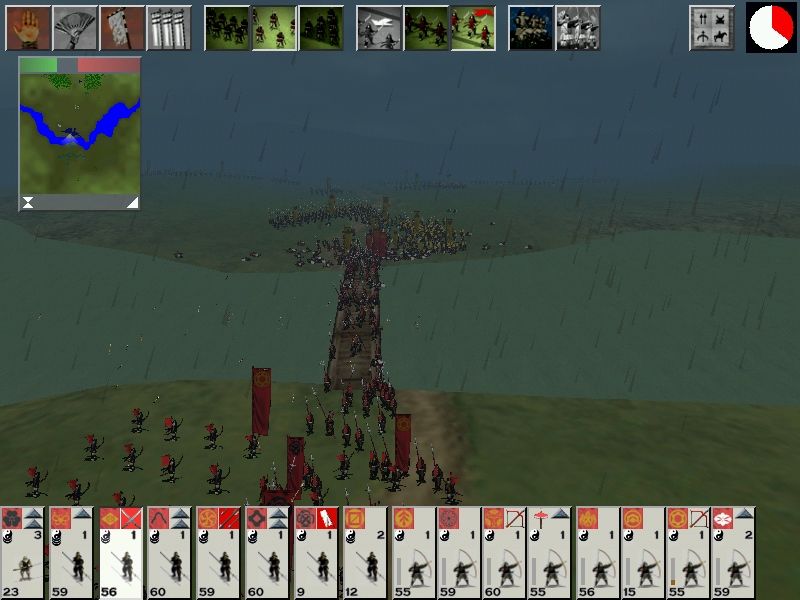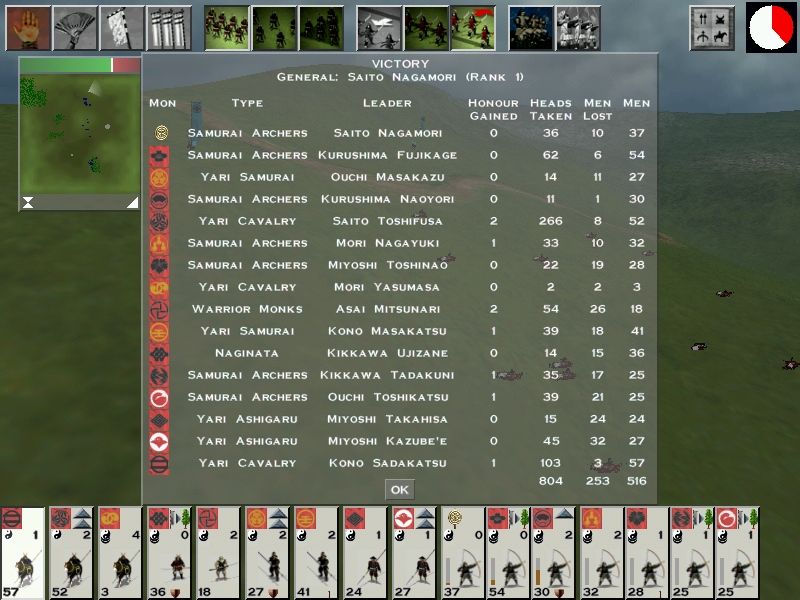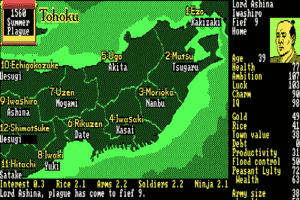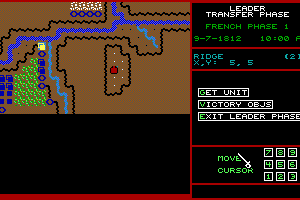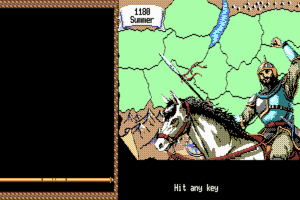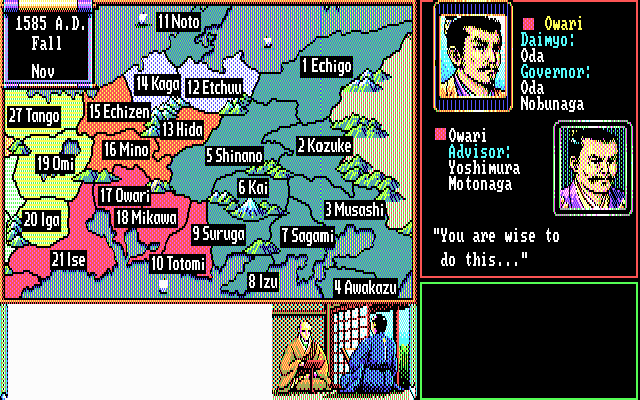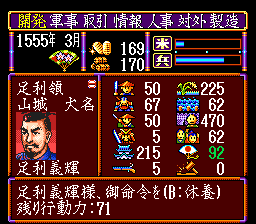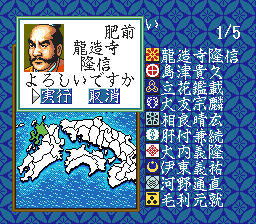Shogun: Total War
Windows - 2000
Description of Shogun: Total War
The Hidden Fortress
When a game sits in development for as long as Shogun has, it's easy to expect the worst. Delayed games have an odd tendency to feel either unfinished or stale upon release: either the delay is not long enough to fix the bugs, or the bugs get fixed but the whole project has been left behind by more current titles which were conceived later but stuck to their production schedule. Shogun is a rare case where the extra time was clearly sufficient not only to complete the game and kill all the bugs, but also to apply a level of polish you'd expect from a deep-pocketed publisher like EA. As the Silver medal at the top of this review shows, underneath that polish is one splendid game. Shogun is a historical strategy game covering the feudal warfare on the Japanese islands in the 16th and 17th centuries. Players control a Japanese clan seeking to become Shogun of all Japan. The strategic game is turn-based and superficially like Risk, where players move armies from province to province (each province is a "space") and build structures like castles and mines to build units and collect resources (koku). When two opposing forces occupy the same space, combat is resolved via an excellent real-time tactical engine. The forces you have on the strategic map are the ones with which you fight the battle, and each province has different (fixed) terrain with its own quirks and nuances. Terrain ranges from lowlands to rolling hills with forests to river valleys and rocky highlands. It's a strategic/tactical system that many gamers have been wishing for (a similar lament is often repeated about the lack of a tactical engine for Warlords III: Darklords Rising) and Shogun does a good job of integrating two different game engines and coming up with a robust combination.
Drunken Angel
Shogun can actually be played in several modes. The campaign game is the most involved and probably the most appealing, although there are also historical battle scenarios such as Nagashima and 4th Kawanakajima. There is also a "custom battle" game (available in multiplayer as well) in which forces can be selected from a pool, although there is no map editor. Instead, play takes place on one of the provincial maps. Without the campaign game, Shogun would be a very enjoyable RTS game with serious depth. With the strategic element of the campaign game, Shogun acquires a context that enhances both the strategic and tactical angles.
I refuse to use the tired reviewing cliché "epic in scope" to describe Shogun's campaign game, so being the hack writer that I am, that leaves me fresh out of ideas. Whatever you call it, the feel of the campaign is absorbing. Each province has certain characteristics, such as unique terrain, an agriculture/resource rating (which determines how much it produces), and loyalty to the Daimyo (leader) of the clan which currently owns it. Provinces can have improvements built on them, such as agricultural upgrades that increase production, mines that provide a fixed revenue, ports, and castles. Instant movement is possible between provinces that have ports, as there are no ships and there is no naval combat. Castles allow the production of buildings, and these buildings in turn produce troops of various types, each of which is based on historical troops and has distinctive strengths and weaknesses. In the tactical game, this variety yields outstanding depth of gameplay. The strategic game was initially a bit disappointing in that it's very straightforward and might not satisfy some hardcore strategy gamers' desire for micromanagement. Each turn represents one "season" (spring, summer, fall, and winter). In order to produce units, provinces must have castles, which can then produce various buildings which allow the training of different military units. A Spear Dojo, for example, will immediately permit the production of Yari Ashigaru (peasant soldiers) and Yari Samurai (spear-equipped warriors), but in order to produce Naginata (infantry with heavier armour and curved swords) you need both a Spear Dojo and an Armoury. Heavy Cavalry requires both a Spear Dojo and a Horse Dojo, and so on. Only one structure can be built in a province at a time, and this construction typically takes between six and ten seasons depending on the building. Because of this, and the relatively small number of provinces on any given part of the map, strategic play in Shogun is somewhat chess-like, where players need to look many turns into the future but can only perform a few actions in any one turn. This part of the game will appeal to players looking for a strategy game that requires precise play and careful thought, although some elements (such as ninjas and geishas) don't seem to have been integrated very well into the overall design. Harvests come but once a year (every four turns) and allocating this income to buildings and troops is an important part of grand strategy.Shogun is not a game where you can just crank out lots of troops, throw them at the enemy, and hope to be successful.
Throne of Blood
Tactical play is rather more intense, but no less cerebral. Done in real-time, the tactical battles combine beautiful terrain with fluid movement. The units themselves are rather low-resolution, and this may turn some people off who don't like the contrast between the gorgeous terrain and the blob-like soldiers. This was apparently done for a reason, though, as each individual soldier supposedly has his own AI. This is evident in the way battles play out, where individual units get into personal combat and fight independently, although they follow orders given to their parent unit. Combat is resolved on a soldier-to-soldier (and not unit-to-unit) basis, even when there are 1,000 soldiers on a side. Allegedly, a design decision was made to limit the detail on the combat units because the CPU can only handle so much. Whether or not this is true, I didn't find the unit graphics to be a problem, although others have disagreed with me. It's true that it's difficult to distinguish between units sometimes, which is why there is a label function where passing the cursor over a formation of units displays its identity, size, and (for friendly units only) levels of morale and exhaustion. Units are also selectable using a display at the bottom of the tactical screen, and double-clicking on a unit tab moves the camera to that unit's perspective. The tactical portion of the game is a triumph. While the demo showed off the beautiful terrain and gave a hint of gameplay, the full game is a true revelation. The system is fairly simple, but the mechanics combine in such a way as to make it very challenging. Troops are rated for armour, attack, defence, morale, speed, weapons, and a very important attribute called "honour." The more honourable your troops are, the more effective they are in combat. Success in combat brings more honour for units that perform well, which forces a player to utilize valuable units in order to keep increasing their honour. Honour can also be gained when a unit is first built by upgrading certain structures to "famous" or "legendary" status. There is a complex relationship between unit types and formations, and combined arms tactics are absolutely required for victory.
Terrain is a crucial part of Shogun, and the player who best uses the terrain to his advantage will usually win unless the odds are really stacked against him. Elevation is particularly important, and troops climbing hills will tire quickly, while archers with a height advantage on their targets become much more effective. Troops can be hidden in the woods, and because elevation affects spotting, units in woods on a high hill will often be invisible until the enemy gets too close, inviting a devastating charge. Battles in river provinces depend on bridges, and making a contested crossing requires careful planning and usually involves heavy casualties even if successful.
One Wonderful Sunday
The beautiful thing about Shogun is that the details that make it so immersive also have a meaningful impact on gameplay. For example, there is a weather system which can lead to battles being fought in all sorts of conditions, from fog to rain to snow or bright sunshine, and gradations of each. This creates a great atmosphere, especially with sound effects like thunder during heavy rainstorms. The elegant part of the design is that conditions can change during play, and these have a significant impact on the game. For example, the aforementioned rain renders firearm troops - like arquebusiers and musketeers - unable to fire. During one scenario, I found that the rain stopped a few minutes into the battle. Nice and atmospheric, but I only realized some time later that my arquebusiers were able to fire. This is a perfect example of a single game design element serving multiple purposes, and is quite clever. Battles fought during the winter season take place on snow-covered terrain, and have appropriate weather.
The strategic game has its share of inspired design elements as well. Each clan has a Daimyo who must be kept alive. Killing an enemy Daimyo removes that clan from the game permanently, and turns its soldiers into leaderless rebels. In keeping with its focus on historical recreation, though, heirs are periodically born and once they reach the age of sixteen, they can carry on as Daimyo if their clan's Daimyo is killed. Thus, there are times when you might not be anxious to risk your Daimyo and his royal escort in battle, but this won't always be the case. Ninjas can be used to assassinate enemy generals. Since generals are extraordinarily difficult to kill in combat, assassination is often the preferred strategy.
The only difficulty with "strategy" is that the AI has a difficult time employing it. The campaign AI is in a pretty sorry state, and this deficiency is compounded by the fact that there is no multiplayer campaign, so the AI is the best competition you'll get. The diplomacy system is rudimentary and doesn't have much discernable effect on gameplay, since it's possible to attack an ally with no penalty, and the AI will attack its allies whenever it chooses. If the tactical game is polished, the strategic game is not, and in places it seems like it was constructed without adequate testing. The overall campaign framework, though, adds immeasurably to the appeal of the tactical game. Despite the shortcomings of the campaign itself (which definitely isn't mean to stand alone) EA and Creative Assembly have managed to make the strategic system just involved enough to make it an excellent sauce for the tactical combat engine. The campaign game is fixed in that the same clans control the same territory each time and have the same starting units. It's also fairly scripted, in that it attempts to recreate the facts of Japanese history via specific events. European traders will arrive at a certain point and offer to set up trading posts. Accepting the Europeans means accepting Christianity, but also permits the utilization of European gunpowder technology. This risks revolt by your Buddhist population, and the need to balance trade income, military strength, and building development is a crucial consideration during the campaign. Each province has a loyalty rating, and only through extended garrisoning of captured provinces does this loyalty increase. But troops stuck bringing a recalcitrant province to heel aren't fighting battles, and this connection between the armies on the strategic map and the tactical advantage or disadvantage you find yourself faced with in a battle is what elevates the campaign game from the category of interesting RTS game to a must-play for all strategy fans.
Quiet Duel
As stated above, multiplayer Shogun is hampered by the fact that you can't play the campaign game. Instead, players choose a battlefield (from the individual provinces or historical battles) and buy troops according to a predetermined (and adjustable) koku limit. While the turn-based nature of the strategic game would mean a lot of dead time for players while battles were fought during other players' turns, this seems like a cop-out to me. There are plenty of gamers who online turn-based games, and the inclusion of campaign multiplay would mean that Shogun could attract a lot of people who might not be as interested in just an online RTS game. Another drawback is that TCP/IP play is limited to the EA Play matchmaking service. The registration process at totalwar.com is annoying and unnecessary.
The actual multiplayer game itself, though, is quite fun, and I was able to play what seemed like a perfectly lag-free game on my notoriously unreliable 56k dialup connection, against another person with a similar connection. There is nothing quite like a good human opponent, and Shogun is tactically rich enough to require some involved decision-making. Troop selection is critical, as the fact that troops with higher honor can be purchased at increased cost means that there are significant decisions to make about force composition even before the initial deployment on the map. Once on the field of battle, all the strong points of the single-player tactical game are on show, except that against a skilled human opponent you have to be a lot sharper.
Scandal
Shogun does have one glaring fault, and that's the documentation. The manual is a typical EA job which gives the barest details necessary to play, spends an inordinate amount of time on the glaringly obvious ("Choosing a Clan," for example) and doesn't even include a summary card or map of any sort. (Actually, the UK version has both a cheat card and a map, while for once U.S. gamers are stiffed.) There are so many undocumented features that its hard to list all of them: basic things like combining units and garrisoning castles aren't even mentioned. This sparse documentation is par for the course with EA, but what makes this absolutely infuriating is that the strategy guide, released simultaneously with the game, is superb. Written by Dean Evans, the guide has individual data pages for each province, a compilation of quantified combat attributes for each unit type, descriptions of each clan's AI, and much more. It even explains exactly how combat is resolved. This kind of information could only be included with the full cooperation of the developers, meaning that EA purposely kept the manual thin and is making gamers pay more to make up for this.
It's too much to expect that all the information in the strategy guide be included in the manual, since some of it is actual strategy hints, but the portions explaining how the game works and explaining how to perform certain game actions should absolutely have been in there. Instead, EA chose the marketing strategy of selling the strategy guide separately. Given the fact that some stores sold Shogun for $30 and gave a $5 discount on the strategy guide when the two were purchased together, it was possible to get the game and guide for $45, which is how much a full-price A-title costs these days. But if you use this as justification, why not sell the CD alone for $25, the manual for $3, and the empty box for $2? And those little registration cards for 10 cents each? As our own Dean Gordon used to famously say, "Bad EA."
Rhapsody in August
Despite the lack of proper documentation, poor campaign AI, the absence of campaign multiplay, and the fixed nature of the campaign game in general, Shogun is a darn good game. The wonderful tactical battles are made immeasurably more interesting by the presence of the strategic wrapper, and even though a more detailed and involved strategic game would have been nice, the one that's there provides plenty of gameplay.Shogun is a solid "Highly Recommended" accolade winner, and one that any strategy fan should make sure to pick up.
Review By GamesDomain
External links
Captures and Snapshots
Comments and reviews
Write a comment
Share your gamer memories, give useful links or comment anything you'd like. This game is no longer abandonware, we won't put it back online.
Buy Shogun: Total War
Shogun: Total War is available for a small price on the following website, and is no longer abandonware. You can read our online store guide.
Similar games
Fellow retro gamers also downloaded these games:

